Zican Dong
Domain-Specific Pruning of Large Mixture-of-Experts Models with Few-shot Demonstrations
Apr 09, 2025Abstract:Mixture-of-Experts (MoE) models achieve a favorable trade-off between performance and inference efficiency by activating only a subset of experts. However, the memory overhead of storing all experts remains a major limitation, especially in large-scale MoE models such as DeepSeek-R1 (671B). In this study, we investigate domain specialization and expert redundancy in large-scale MoE models and uncover a consistent behavior we term few-shot expert localization, with only a few demonstrations, the model consistently activates a sparse and stable subset of experts. Building on this observation, we propose a simple yet effective pruning framework, EASY-EP, that leverages a few domain-specific demonstrations to identify and retain only the most relevant experts. EASY-EP comprises two key components: output-aware expert importance assessment and expert-level token contribution estimation. The former evaluates the importance of each expert for the current token by considering the gating scores and magnitudes of the outputs of activated experts, while the latter assesses the contribution of tokens based on representation similarities after and before routed experts. Experiments show that our method can achieve comparable performances and $2.99\times$ throughput under the same memory budget with full DeepSeek-R1 with only half the experts. Our code is available at https://github.com/RUCAIBox/EASYEP.
LongReD: Mitigating Short-Text Degradation of Long-Context Large Language Models via Restoration Distillation
Feb 11, 2025Abstract:Large language models (LLMs) have gained extended context windows through scaling positional encodings and lightweight continual pre-training. However, this often leads to degraded performance on short-text tasks, while the reasons for this degradation remain insufficiently explored. In this work, we identify two primary factors contributing to this issue: distribution drift in hidden states and attention scores, and catastrophic forgetting during continual pre-training. To address these challenges, we propose Long Context Pre-training with Restoration Distillation (LongReD), a novel approach designed to mitigate short-text performance degradation through minimizing the distribution discrepancy between the extended and original models. Besides training on long texts, LongReD distills the hidden state of selected layers from the original model on short texts. Additionally, LongReD also introduces a short-to-long distillation, aligning the output distribution on short texts with that on long texts by leveraging skipped positional indices. Experiments on common text benchmarks demonstrate that LongReD effectively preserves the model's short-text performance while maintaining comparable or even better capacity to handle long texts than baselines.
YuLan-Mini: An Open Data-efficient Language Model
Dec 24, 2024



Abstract:Effective pre-training of large language models (LLMs) has been challenging due to the immense resource demands and the complexity of the technical processes involved. This paper presents a detailed technical report on YuLan-Mini, a highly capable base model with 2.42B parameters that achieves top-tier performance among models of similar parameter scale. Our pre-training approach focuses on enhancing training efficacy through three key technical contributions: an elaborate data pipeline combines data cleaning with data schedule strategies, a robust optimization method to mitigate training instability, and an effective annealing approach that incorporates targeted data selection and long context training. Remarkably, YuLan-Mini, trained on 1.08T tokens, achieves performance comparable to industry-leading models that require significantly more data. To facilitate reproduction, we release the full details of the data composition for each training phase. Project details can be accessed at the following link: https://github.com/RUC-GSAI/YuLan-Mini.
LLMBox: A Comprehensive Library for Large Language Models
Jul 08, 2024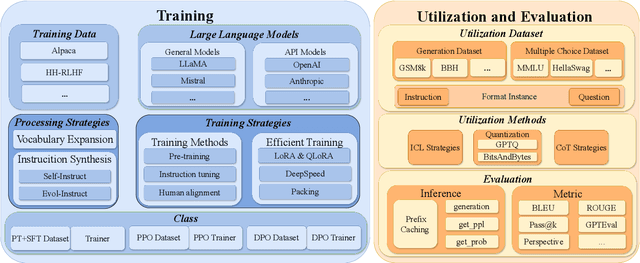
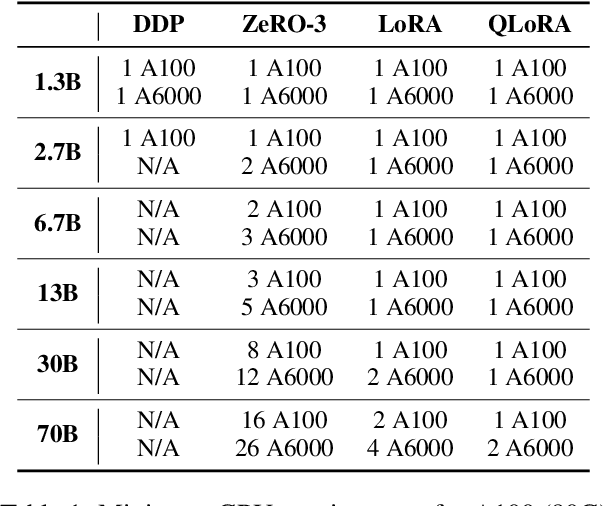
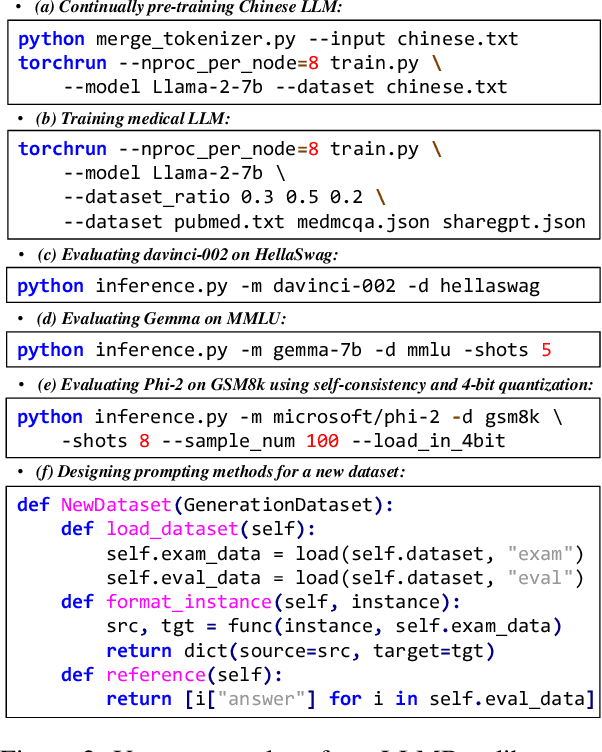

Abstract:To facilitate the research on large language models (LLMs), this paper presents a comprehensive and unified library, LLMBox, to ease the development, use, and evaluation of LLMs. This library is featured with three main merits: (1) a unified data interface that supports the flexible implementation of various training strategies, (2) a comprehensive evaluation that covers extensive tasks, datasets, and models, and (3) more practical consideration, especially on user-friendliness and efficiency. With our library, users can easily reproduce existing methods, train new models, and conduct comprehensive performance comparisons. To rigorously test LLMBox, we conduct extensive experiments in a diverse coverage of evaluation settings, and experimental results demonstrate the effectiveness and efficiency of our library in supporting various implementations related to LLMs. The detailed introduction and usage guidance can be found at https://github.com/RUCAIBox/LLMBox.
YuLan: An Open-source Large Language Model
Jun 28, 2024



Abstract:Large language models (LLMs) have become the foundation of many applications, leveraging their extensive capabilities in processing and understanding natural language. While many open-source LLMs have been released with technical reports, the lack of training details hinders further research and development. This paper presents the development of YuLan, a series of open-source LLMs with $12$ billion parameters. The base model of YuLan is pre-trained on approximately $1.7$T tokens derived from a diverse corpus, including massive English, Chinese, and multilingual texts. We design a three-stage pre-training method to enhance YuLan's overall capabilities. Subsequent phases of training incorporate instruction-tuning and human alignment, employing a substantial volume of high-quality synthesized data. To facilitate the learning of complex and long-tail knowledge, we devise a curriculum-learning framework throughout across these stages, which helps LLMs learn knowledge in an easy-to-hard manner. YuLan's training is finished on Jan, 2024 and has achieved performance on par with state-of-the-art LLMs across various English and Chinese benchmarks. This paper outlines a comprehensive technical roadmap for developing LLMs from scratch. Our model and codes are available at https://github.com/RUC-GSAI/YuLan-Chat.
Exploring Context Window of Large Language Models via Decomposed Positional Vectors
May 28, 2024Abstract:Transformer-based large language models (LLMs) typically have a limited context window, resulting in significant performance degradation when processing text beyond the length of the context window. Extensive studies have been proposed to extend the context window and achieve length extrapolation of LLMs, but there is still a lack of in-depth interpretation of these approaches. In this study, we explore the positional information within and beyond the context window for deciphering the underlying mechanism of LLMs. By using a mean-based decomposition method, we disentangle positional vectors from hidden states of LLMs and analyze their formation and effect on attention. Furthermore, when texts exceed the context window, we analyze the change of positional vectors in two settings, i.e., direct extrapolation and context window extension. Based on our findings, we design two training-free context window extension methods, positional vector replacement and attention window extension. Experimental results show that our methods can effectively extend the context window length.
BAMBOO: A Comprehensive Benchmark for Evaluating Long Text Modeling Capacities of Large Language Models
Sep 23, 2023Abstract:Large language models (LLMs) have achieved dramatic proficiency over NLP tasks with normal length. Recently, multiple studies have committed to extending the context length and enhancing the long text modeling capabilities of LLMs. To comprehensively evaluate the long context ability of LLMs, we propose BAMBOO, a multi-task long context benchmark. BAMBOO has been designed with four principles: comprehensive capacity evaluation, avoidance of data contamination, accurate automatic evaluation, and different length levels. It consists of 10 datasets from 5 different long text understanding tasks, i.e. question answering, hallucination detection, text sorting, language modeling, and code completion, to cover core capacities and various domains of LLMs. We conduct experiments with five long context models on BAMBOO and further discuss four key research questions of long text. We also qualitatively analyze current long context models and point out future directions for enhancing long text modeling capacities. We release our data, prompts, and code at https://github.com/RUCAIBox/BAMBOO.
StructGPT: A General Framework for Large Language Model to Reason over Structured Data
May 16, 2023



Abstract:In this paper, we study how to improve the zero-shot reasoning ability of large language models~(LLMs) over structured data in a unified way. Inspired by the study on tool augmentation for LLMs, we develop an \emph{Iterative Reading-then-Reasoning~(IRR)} approach for solving question answering tasks based on structured data, called \textbf{StructGPT}. In our approach, we construct the specialized function to collect relevant evidence from structured data (\ie \emph{reading}), and let LLMs concentrate the reasoning task based on the collected information (\ie \emph{reasoning}). Specially, we propose an \emph{invoking-linearization-generation} procedure to support LLMs in reasoning on the structured data with the help of the external interfaces. By iterating this procedures with provided interfaces, our approach can gradually approach the target answer to a given query. Extensive experiments conducted on three types of structured data demonstrate the effectiveness of our approach, which can significantly boost the performance of ChatGPT and achieve comparable performance against the full-data supervised-tuning baselines. Our codes and data are publicly available at~\url{https://github.com/RUCAIBox/StructGPT}.
A Survey of Large Language Models
Apr 27, 2023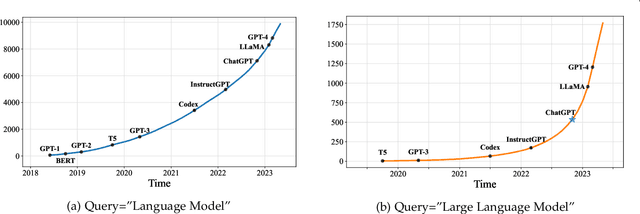

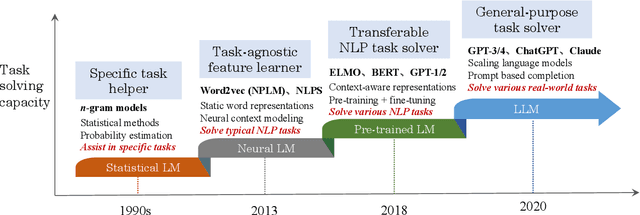

Abstract:Language is essentially a complex, intricate system of human expressions governed by grammatical rules. It poses a significant challenge to develop capable AI algorithms for comprehending and grasping a language. As a major approach, language modeling has been widely studied for language understanding and generation in the past two decades, evolving from statistical language models to neural language models. Recently, pre-trained language models (PLMs) have been proposed by pre-training Transformer models over large-scale corpora, showing strong capabilities in solving various NLP tasks. Since researchers have found that model scaling can lead to performance improvement, they further study the scaling effect by increasing the model size to an even larger size. Interestingly, when the parameter scale exceeds a certain level, these enlarged language models not only achieve a significant performance improvement but also show some special abilities that are not present in small-scale language models. To discriminate the difference in parameter scale, the research community has coined the term large language models (LLM) for the PLMs of significant size. Recently, the research on LLMs has been largely advanced by both academia and industry, and a remarkable progress is the launch of ChatGPT, which has attracted widespread attention from society. The technical evolution of LLMs has been making an important impact on the entire AI community, which would revolutionize the way how we develop and use AI algorithms. In this survey, we review the recent advances of LLMs by introducing the background, key findings, and mainstream techniques. In particular, we focus on four major aspects of LLMs, namely pre-training, adaptation tuning, utilization, and capacity evaluation. Besides, we also summarize the available resources for developing LLMs and discuss the remaining issues for future directions.
A Survey on Long Text Modeling with Transformers
Feb 28, 2023


Abstract:Modeling long texts has been an essential technique in the field of natural language processing (NLP). With the ever-growing number of long documents, it is important to develop effective modeling methods that can process and analyze such texts. However, long texts pose important research challenges for existing text models, with more complex semantics and special characteristics. In this paper, we provide an overview of the recent advances on long texts modeling based on Transformer models. Firstly, we introduce the formal definition of long text modeling. Then, as the core content, we discuss how to process long input to satisfy the length limitation and design improved Transformer architectures to effectively extend the maximum context length. Following this, we discuss how to adapt Transformer models to capture the special characteristics of long texts. Finally, we describe four typical applications involving long text modeling and conclude this paper with a discussion of future directions. Our survey intends to provide researchers with a synthesis and pointer to related work on long text modeling.
 Add to Chrome
Add to Chrome Add to Firefox
Add to Firefox Add to Edge
Add to Edge